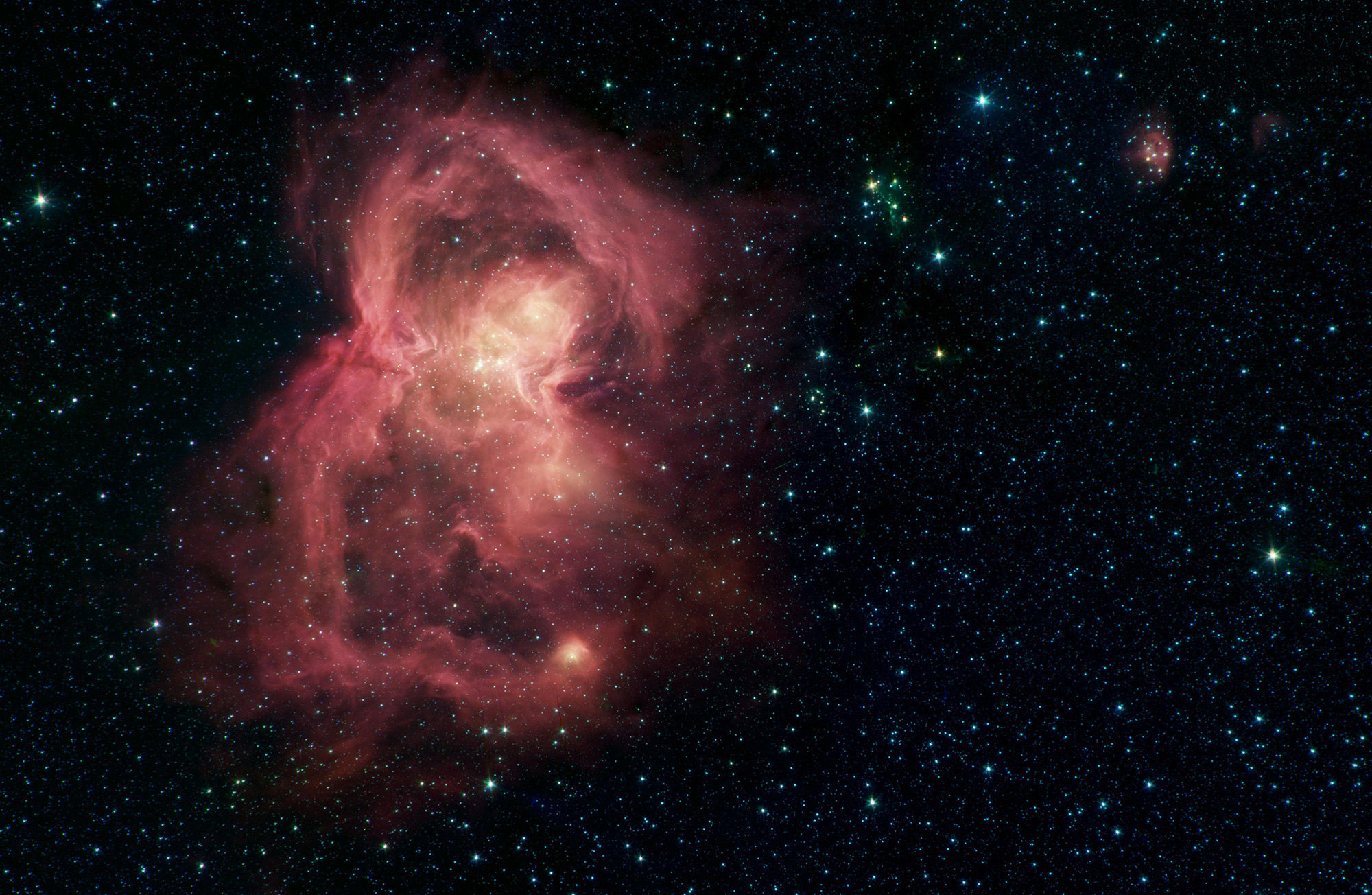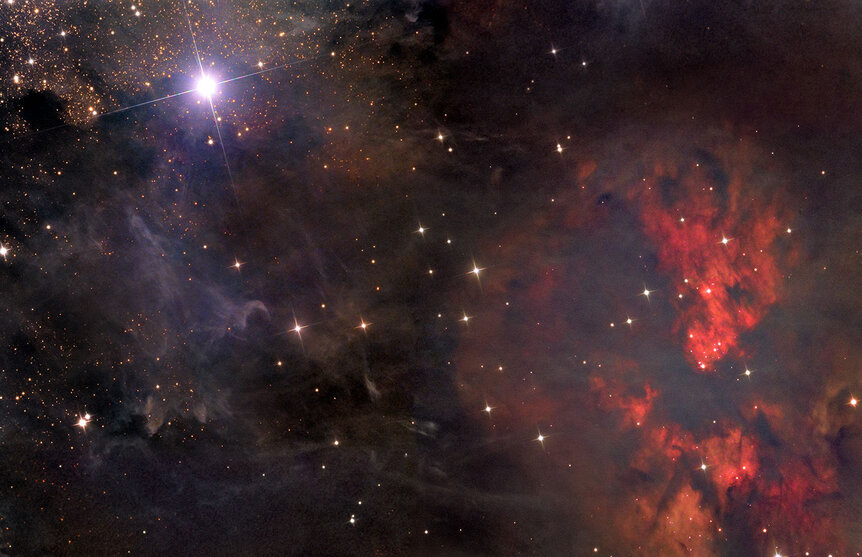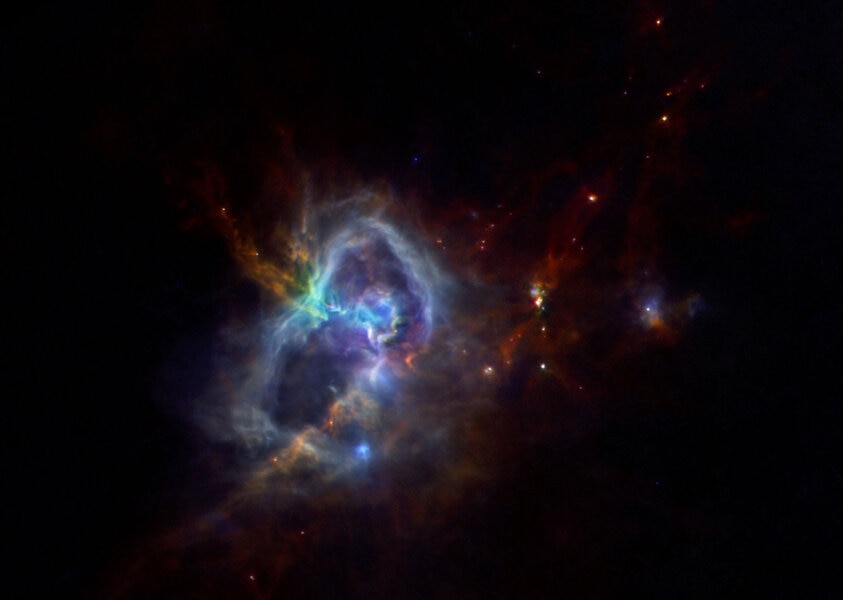Create a free profile to get unlimited access to exclusive videos, sweepstakes, and more!
Westerhout 40: A waist of space

I'm fascinated by nebulae. These gas clouds littering the Milky Way come in many shapes and sizes and colors and brightnesses. Some mark the deaths of stars, and many are where stars are born.
These stellar nurseries are some of the most celebrated objects in the sky. Who doesn't love the magnificent Orion Nebula, so huge and bright and loaded with massive, luminous stars that even at a distance of 1,300 light years — 13 quadrillion kilometers! — it's visible to the unaided eye?
But in the opposite corner of the sky is another nebula, smaller and less well known than Orion, which recently caught my eye. It's certainly lovely, and scientifically interesting, but there’s also something weird about it I can't quite explain, and haven't found much help in the scientific literature.
First, though, let's take a look, shall we? Here is Westerhout 40 (or W40 for short), aka Sharpless 2-64:
How gorgeous! This image is from the Spitzer Space Telescope, which is sensitive to light in the infrared, with much longer wavelengths than our eye can see. The reddest we can see is about 0.8 microns or so, and this image is a composite of four observations made at 3.6, 4.5, 5.8, and 8.0 microns (displayed, respectively, as blue, green, orange, and red). So this is way outside what we can see.
Although you may be used to hydrogen gas glowing red, in this image the red material is actually a complex carbon-based molecule called a PAH, for polycyclic aromatic compound. It's basically soot. Yes, soot. It's being warmed by stars around it, causing it to glow in the far infrared.
W40 is a star-forming cloud that’s part of a huge complex of dark, cold clouds sprawled across the sky in the constellation of Aquila, where there are lots of smaller regions forming stars. The distance to W40 isn't well known; I see lots of references saying it's 1,400 light years away, but a team of astronomers argues it's much closer at 850 light years. They make a good case, too.
Either way, the clouds in that region contain molecular hydrogen (H2, two atoms of hydrogen bonded together) and lots and lots of dust — grains of rocky material as well as the complicated carbon molecules. This stuff, formed in the winds of dying and exploding stars, is seriously opaque to visible light, so when you look at W40 with an optical telescope you get a very different, if no less beautiful view:
That image was taken by my friend Adam Block using a 0.8 meter telescope, and represents a near-natural color display (red, green, and blue). W40 is the reddish area to the lower left. I played around with this image a lot, comparing it to other observations of the nebula, and found that you have to rotate it 90° clockwise to get it at the same orientation as the Spitzer one, but good luck finding any correspondence! The stuff that looks dark in Adam's shot is dust, which is what glows in the Spitzer image, but even then figuring out what’s what is difficult. You're welcome to try (and hint: The bright star in his image is HD 170818), but I made little progress.
Anyway, in the infrared image you can see a bunch of bright stars in the middle of the cloud. Those stars are young (probably less than a million years old), and many of them are very massive. One is a beast, IRS 1A South, a massive O-type star that's nearly 8 times wider than the Sun and likely blasting off 50,000 times as much energy as the Sun does! This single star is responsible for most of the energy pumped into the nebula, with a handful of other slightly lower mass stars adding their contribution.
But something bugs me, and that's the overall shape of the nebula. Note that in the infrared, it looks like an hourglass. I can think of two reason that might be, and I'm not sure which is right.
When stars are young, they spin rapidly. This slows over time as they blow off a solar wind, which interacts with their magnetic field, acting like a parachute. But when a star is very young it may still have a disk of material around it from which it forms. This blocks the wind, forcing it to blow up and down, expanding away in … an hourglass shape. IRS 1A South is such a powerhouse I might believe it could be behind this sculpting of the nebula.
But also, W40 is embedded in much denser, colder, dark material. If it happens to lie in a region of this material that’s flat, like a sheet, that too could prevent the nebula from expanding in that direction, again shaping it into an hourglass. Interestingly, I found this image of it even farther out in the infrared by ESA's Herschel space telescope:
Right along the waist of the nebula is a big arc of material, and I wonder if that has anything to do with the hourglass. It may be coincidence, or may be affiliated with W40 but have nothing to do with its shape. I'd wager it's the star IRS 1A South doing the carving here, but I can't be 100% sure. I’ve read several papers on this object now and it's difficult to find anyone making firm conclusions.
Still, it's a beautiful object at any wavelength. I wonder what the view of this will be when the huge infrared James Webb Space Telescope takes a peek at it? I imagine we'll find out eventually. Until then, by some long chance that any astronomer out there knows the answer to my mystery, I'd love to hear it!





























